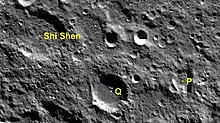
Shi Shen (Chinese: 石申; Wade–Giles: Shih Shen, fl. 4th century BC) was a Chinese astronomer and astrologer. He was a contemporary of Gan De born in the State of Wei, also known as the Shi Shenfu.
Observations
Shi is credited with positioning the 121 stars found in the preserved texts. Shen also made the earliest surviving deliberate sunspot observation, sometimes erroneously credited to Gan De. He assumed that these spots were eclipses that began at the center of the Sun and spread outward. Although he was wrong, he recognised the spots for what they were – solar phenomena.
His works included the 8-volume The rocks of Space, the one-volume Celestial Map and the one-volume Star Catalogue of Shi. The latter two are now believed to be written by his school followers. Most of his works did not survive intact, but a few of his crucial writings were preserved in the Treatise on Astrology of the Kaiyuan Era.
Books
Shi Shen wrote the Astronomy (石氏天文, Shishi Tianwen), later known as Shi's Classic of Stars (石氏星經, Shishi Xingjing).
Influence
Gan De and Shi Shen are widely quoted across a number of astronomical texts after their time, though they should not be confused with other books sharing similar names that were not written by them. One example is the Star Manual of the Masters Gan and Shi (甘石星經, Gan Shi Xingjing), which was actually compiled by Ma Xian (馬顯) circa 579 AD as an appendix to a calendar treatise.
The crater Shi Shen on the Moon is named after him.
See also
Notes
- His courtesy name is written differently in sources; in Hanshu 30 his name was listed as Shi Shenfu (石申夫), Shi Shenfu (石申甫) as in Old Book of Tang 51, and Shi Shenfu (石申父) under a commentary in Hou Hanshu 100. Though he was simply known as Shi Shen under Shiji 27.
- Milone, Eugene F. Humiston Kelley, David. Exploring Ancient Skies: An Encyclopedic Survey of Archaeoastronomy. (2005). ISBN 0-387-95310-8
- The first dated record of sunspots is found in the Hanshu which records an observation made 10 May 28 BC.
- Kaiyuan Zhanjing Vol. 6.
- a.k.a. the Shi's Treatise on Stars.
- Suishu 34 listed three of his works together, the Tianwen (天文), Huntian Tu (浑天图) and Shishi Xingbu Jingzan (石氏星簿经赞) a.k.a. Shishi Xingjing Buzan (石氏星经簿赞).
- Peng, Yoke Ho (2000). Li, Qi and Shu: An Introduction to Science and Civilization in China. Courier Dover Publications. ISBN 0-486-41445-0
- Kistemaker, Jacob. Sun, Xiaochun. (1997). The Chinese Sky During the Han: Constellating Stars and Society. BRILL publishing. ISBN 90-04-03938-4.
References
- Du Shiran; et al. (1992). Biographies of Ancient Chinese Scientists Series One: Shi Shenfu. Beijing: Kexue Chubanshe. pp. 22–25. ISBN 7-03-002926-7.
{{cite book}}: External link in|title= - Zhu Genyi; et al. (1999). Concise Spotlight on Who in the World of Science and Technology. Beijing: Zhongguo Kexue Jishu Chubanshe. pp. 2–3. ISBN 7-5046-2602-3.
- Dick Teresi (2003). The Ancient Roots of Modern Science--from the Babylonians to the Maya. New York: Simon & Schuster. p. 148. ISBN 0-7432-4379-X.